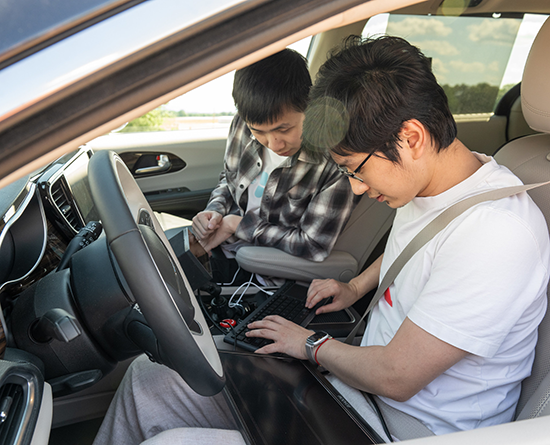Penn State and Royal Truck enhance autonomous attenuator truck capabilities
Nathan Snizaski
Aug 11, 2025
Highway maintenance crews often work at slow speeds—sometimes less than 10 miles per hour—while painting lines or repairing pavement. That makes them especially vulnerable to unsafe drivers. If a passenger car were to rear-end one of these trucks, the worker inside could be severely injured or even killed.
To address this danger, Royal Truck & Equipment (Shoemakersville, PA) developed the world’s first Autonomous Truck Mounted Attenuator (ATMA) truck. This driverless “crash cushion” vehicle follows closely behind a manned lead truck, serving as a moving shield. In the event of a rear-end collision, the autonomous follower vehicle would absorb the impact—sparing human lives.
Royal Truck is the only vendor in the market that has both developed and deployed the market-proven ATMA technology. Recently, the company partnered with researchers from Penn State to enhance the resiliency of the ATMA vehicle system in GPS-denied locations.

Penn State students Chenxi Chen (left) and Yuxin Ding (right) testing the algorithm developed for this project.
“Normally, when a GPS signal gets lost, navigation systems will switch to dead reckoning using data from the vehicle’s inertial sensors (accelerometers and gyroscopes)—and sometimes wheel encoders—to calculate how the vehicle should proceed,” says Xianbiao ‘XB’ Hu, associate professor of civil and environmental engineering at Pennsylvania State University. “This works if the GPS signal is lost briefly, but accumulated error makes it unreliable during long-term GPS outages.”
To solve this problem, Hu’s team turned to LiDAR—a laser-based sensing technology that measures distances by bouncing light off surrounding objects. By equipping both the lead and follower vehicles with LiDAR sensors and cameras, the team developed a system with SLAM (Simultaneous Localization and Mapping) algorithms that enables the autonomous follower to align its sensor data with that of the lead vehicle in real-time.
“We deemed this concept an asynchronous view representation,” says Hu. “The follower vehicle matches its LiDAR information with the lead vehicle, but with a time delay. This helps the autonomous vehicle identify its location at a given moment and decide whether to keep moving, slow down, or stop.”
The ATMA leader-follower operation collects velocity, heading, and position information of the leader truck and transmits this information in packets of data, called “crumbs,” to the unmanned follower vehicle over the vehicle-to-vehicle (V2V) communications link.
Hu explains: “The crumbs are essentially information that the leader vehicle sent to the follower vehicle, almost like a pulse sent out at certain frequencies to communicate with each other through V2V communication. The two vehicles are always in communication— even when the vehicles enter a GPS-denied area—which will help keep the unmanned vehicle at a safe distance from the manned lead vehicle.”
The research team tested various algorithms on automated vehicles at the Penn State Smart Mobility Lab, utilizing a full-scale facility managed by the Penn State Larson Transportation Institute. Located just minutes away from campus next to the State College Regional Airport, the test track was initially designated by the U.S. Department of Transportation as one of ten national AV proving grounds. The facility features a one-mile oval test track used for AV testing and mobility behavior modeling.
“Penn State’s test track is a controlled facility with no external traffic or pedestrians,” says Hu. “It provides a wonderful environment for us to test a new technology before it matures. We are free to set up all kinds of devices, such as stop signs and pavement markings, which is incredibly helpful to our research.”
This project will significantly improve the system’s technical accuracy, thereby increasing its potential to help protect and provide safety for highway workers.
Thomas Pucci, government accounts manager, Royal Truck & Equipment
Hu sees broader applications for this technology, such as vehicle platooning, where trucks travel in coordinated formation on highways.
“Pennsylvania is a big player in AV and robotics research,” says Hu. “For example, in Pittsburgh, there are multiple notable companies investigating fleet platooning. On the freeway, you could have 10 commercial trucks, driving together, following a lead vehicle. Our technology could perhaps contribute to that effort, making commercial transportation across the country safer and more efficient.”
“This project has been a unique experience that allowed me to apply the knowledge we learned to real industry challenges,” says Yuxin Ding, Ph.D. student at Penn State. “It helped me understand why making automated vehicles resilient to diverse driving environments is such a critical problem for large-scale deployment. I’m especially proud that our team identified the repetitive view patterns in leader–follower Cooperative Driving Automation technology to improve positioning accuracy under GPS-denied conditions while staying computationally efficient.”
Hu credits the Manufacturing PA program for making the collaboration with Royal Truck possible.
“As researchers, it’s incredible to have the opportunity to make a difference, which can be very different in scope from the other funding opportunities. We’re grateful for the opportunity to work on a meaningful industry problem that matters to the company and contributes to public safety.”